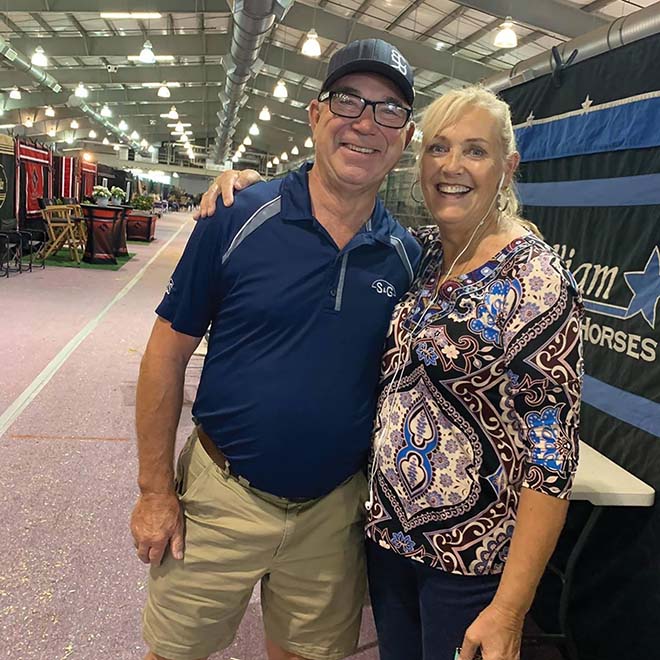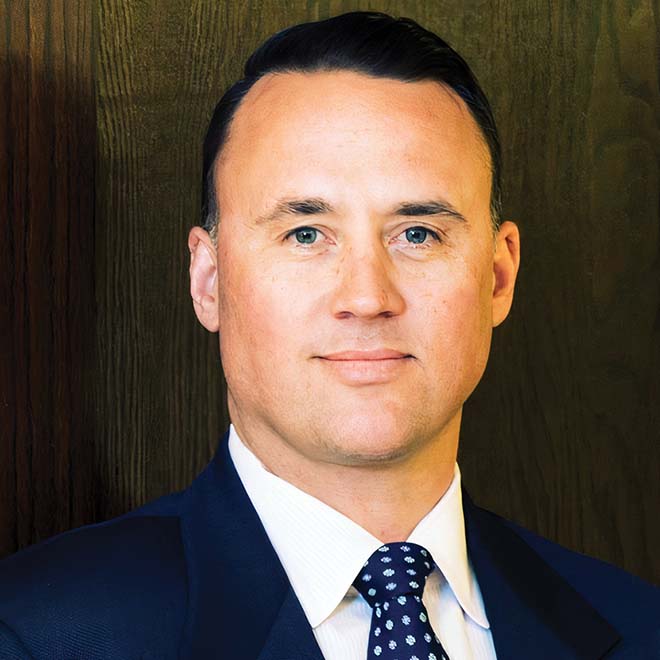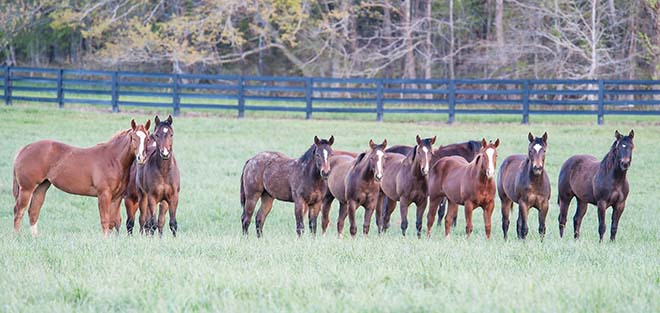
Deciding to insure a show horse depends on two things: your long-term goals and the level of risk you’re willing to accept.
Not enough insurance for a valuable stallion or top-level show horse can keep you awake worrying about infertility or a career-ending injury. On the flip side, you can purchase so much insurance that you’re spending more than what is necessary.
In the early 1990s, exhibitor Janet Gunn, of Greensburg, Indiana, began purchasing mortality and major medical policies for her show horses. It was the first-time Gunn owned horses expensive enough to need insurances. Her trainer referred an agent and it’s a practice she’s continued ever since then.
“We have only had one instance when a horse died, many years ago,” she said. “Our agent, Johne Dobbs, helped us facilitate the process, and the company paid promptly. Like much insurance, it’s an option one hopes will never be needed. It is a wonderful resource when the unexpected happens.”
The first question to ask yourself is “if something happens to the horse do you want to replace it?” Assuming the client’s answer is “yes,” next consider if you have access to enough money to replace the horse without the financial assistance of an insurance claim. For some, that buffer may be $10,000 for others that threshold could be much higher.
Typically, most trainers, exhibitors and breeders don’t have mid-five to six figures stashed saved for buying a new horse. While your threshold is likely far less than six figures, it is worth considering what amount of cash you would need to replace an injured or deceased horse.
Once you decide to insure your horse, the options can be overwhelming. In the article that follows, three insurance experts offer insight into different policy types and offer scenarios for when each might make a good investment.
Mortality insurance
Essentially mortality insurance is a life insurance policy for your horse. The policy value is typically equal to the horse’s purchase price assuming the policy is purchased when the horse is first bought and is renewed annually, explained Evan Kaplow, the Director of Equine for Mark Edward Partners, LLC, New York.

“We can look to increase the amount of coverage from the purchase price if the horse is accumulating points, having big wins or earning money,” he said.
North Carolina-based equine insurance agent Johne Dobbs explains that full mortality premiums are based on a percentage of the insured value with percentage being between 3% and 4%. Dobbs works alongside her daughter, Courtney Clagg, for Andreini & Co and represent various companies.
This depends on the use, breed and age of the horse. An example is an 8-year-old all-around horse insured for the value of $10,000 would between $325-$345 a year and include $5,000 emergency colic surgery. Always call your agent for specifics when insuring your horse.
A veterinarian exam is only required if the horse’s value is over a certain limit or if the horse has had a health issue in the immediate past, according to Jackie Starnes, owner of Starnes Equine Insurance in Summerton, South Carolina. Typically, horses under $100,000 do not require a veterinarian exam, Starnes said though he strongly recommends that one is done and that the narrative report is included with the insurance application.
“This is protection for you to have it on file with the underwriting,” he said.

Many mortality policies include coverage of emergency colic surgery for horses insured for a minimum of $5,000. The coverage often pays up to 50% of the surgery costs with a $5,000 maximum pay out. Theoretically, a horse insured at $5,000 would get $2,500 and a horse insured at $10,000 would get $5,000 for an emergency colic surgery.
Specified perils policy is sometimes used instead of mortality insurance, Dobbs said. This reimburses the owner for the insured value if the horse was lost to an accident, fire or lightening, and collision as examples. It does not provide as much coverage and is usually only used for horses that are too old to insure for full mortality.
“It’s a simple process,” Dobbs said. “The application is often emailed to the applicant to complete and return. Immediate coverage is usually available if the horse has been healthy and if recently acquired is being insured for the purchase price.”
Major medical
Major medical was originally designed for catastrophic veterinarian expenses caused from an illness, disease or injury, according to Dobbs. Over the years, insurance companies have added deductibles and co-pays to the major medical coverage. The major medical covers diagnostics, certain treatments and hospitalization as well as surgery including colic.
The coverage is purchased as an enhancement to a mortality policy. Once your horse is insured, you are required to provide any care necessary to save the horse. If your horse is faced with colic surgery and you opt not to put the horse through the stress of surgery and choose to euthanize, the company is not obligated to pay on the policy. If all means are taken to save the horse and the horse does not make it, then you will be paid on the policy.
Lameness, sickness and disease that develops while a horse is insured under a major medical policy is covered. A significant benefit to these policies is the colic surgery coverage that can be added to the coverage available with some mortality policies. A $10,000 major medical plan offers up to $10,000 for colic surgery. Add that to the $5,000 coverage available under most mortality policies and that goes a long way in covering an emergency colic surgery.
Major medical pricing is pre-determined by the insurance carrier you are apply coverage from. The deductibles and co-insurance are also pre-determined and vary company to company. It is very important to understand the differences between the companies and plans before you purchase.
“Typically, injections and pre-existing or hereditary conditions are not covered,” Kaplow said.
Infertility or Accident, Sickness, Disease
Because breeding stallions have an opportunity to create revenue, owners often insure the fertility of the stallion, Dobbs said. A vet exam is required, with a reference to the stallion’s genitalia being satisfactory for breeding.
“This provides coverage should your stallion become totally and permanently impotent, infertile or incapable of serving mares due to an injury or illness,” she added.
The stallion’s estimated value is determined based on his stud fee and the number of mares he has settled, over a given period of time. Some insurance companies call this policy Infertility insurance, others call it ASD.
Similar to permanent disability insurance for humans, ASD policies provide reimbursement for an inability to “work.” For stallions, that’s serving mares. The coverage does not cover congenital issues.
“These policies kick in if a stallion has hurt a hock or stifle and won’t mount a phantom or dummy or won’t provide semen because it is so painful,” Kaplow said. “If a proven breeding stallion contracts Pigeon fever and this fever caused him to be sterile that is covered. Colic or intestinal issue that affects fertility because the stud has to be castrated to save his life would be covered.”
Before a policy is approved, a vet exam is needed to confirm that the horse has adequate genitalia and, the horse needs to “be proven.” A stallion as young as 2 may be eligible for coverage if he has a satisfactory number of mares in foal as proof of being viable as a stallion, Kaplow says.
“Policies can be started mid-season if the stallion already has a number of mares in foal,” he said. “Then, if there is accident/sickness/disease there was proof the horse was viable before coverage and they don’t have to prove fertility.”
What about babies and broodmares?
As a breeder, Starnes insures his family’s babies before they are weaned. His believes this is a risky time period and since his family doesn’t raise a lot of horses it is economically sound to cover them.

“This is a personal decision for each owner and breeder,” he said.
Foals in utero can also qualify for coverage as early as 42 to 50 days in gestation, according to Kaplow. Such coverage would remain in effect until foaling and up to 90 days old.
“This is always a consideration especially when a mare owner has paid a hefty stud fee with vet costs,” Dobbs said. “The owner may opt for embryo transfer and there are expenses associated with that procedure. A new foal may be insured as early as 24 hours post foaling.”
Unlike stallions, broodmares are not eligible for infertility policies, however, they can be insured for full mortality and death during the breeding and/or foaling process would be covered. Mares can also be covered by an accident, illness or disease policy.
“It is a personal preference for owners to insure their mares,” Dobbs said. “If the mare has just been purchased, the owner may want to cover their investment. If the mare is a great producer, an insurance policy protects the annual expenses the owner incurs,” Dobbs said.
Other things to know
While policies are typically equal to the horse’s purchase price, proof of accomplishments like breeding or show records can be used to increase a horse’s value and its insurance value. In the case of homebred horses, the breeding fee and record of the dam are taken into consideration to agree on a value, Dobbs explained.
“A weanling that has been raised may be insured for three times the stud fee,” she said. “As a horse matures and the owner incurs training fees and the horse has a show record or purse money the insurance companies will often grant a request to increase the value.”
Kaplow emphasizes the importance of recognizing that policies are renewed annually and have hard dates for when coverage ends. For example, if a policy starts on Nov. 1, 2020 it expires Nov. 1, 2021.
“Horses get sick any time,” he said. “It could be the day after you sign the paperwork or day before it ends. Make sure there is an adequate extension period in event horse gets sick or injured close to end of policy term.”
Available extensions:
• 90 day-extension. Kaplow sees this as the least effective option as coverage promptly ends three months after the policy ends. If a horse develops laminitis at the end of a policy period, you would only have 90 days to make a mortality claim after the policy expires. Once that extension period is up, the horse would no longer be covered for laminitis if it has to be put down or dies.
• 12 month-extension. A step up from the 90-day, this offers coverage for up to a year after a policy ends.
• The most comprehensive plans include a guaranteed renewal endorsement that guarantees the renewal of the policy no matter what. The guaranteed renewal should give you a minimum of 12 months coverage and in many cases even more time to allow the horse to fully recover. The most comprehensive plan I sell does not allow the insurer to put any type exclusion or time restraints to make a mortality claim, Kaplow explains.
“Even though insurance seems like an expensive option, it is important to manage the financial risk we take when investing in our beloved horses,” Gunn said.



You must be logged in to post a comment Login